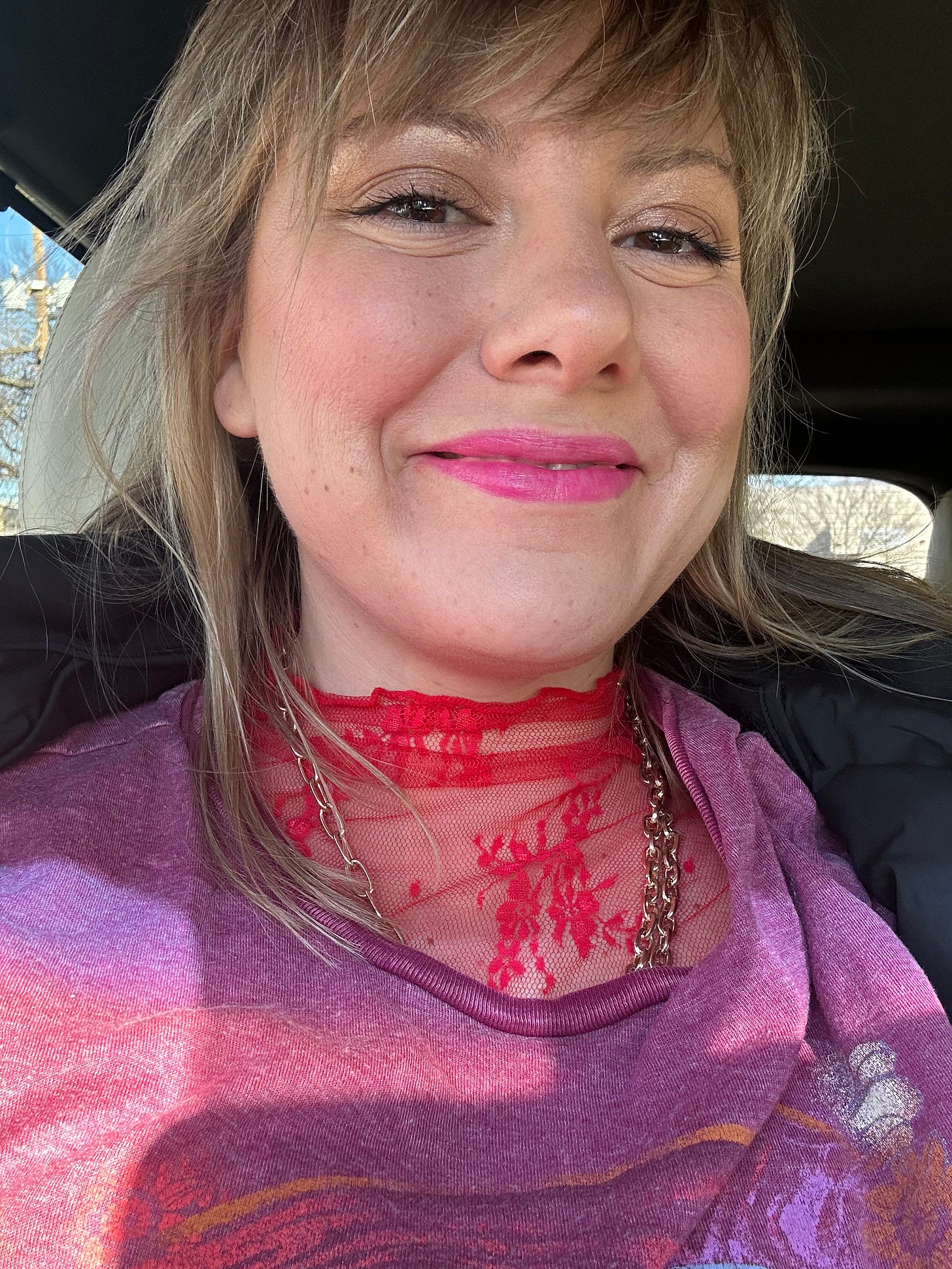When we talk about healing, we often focus on the big moments - the decisions, the breakthroughs, the transformations. But sometimes the clearest measure of growth isn't in those dramatic shifts, but in how we experience the seemingly simple things, like a holiday. Through the lens of three Valentine's Days, I've discovered how our relationship with celebration can become a powerful mirror of our healing journey.
Year One: The Rage Phase (2023)
When anger becomes our first language of grief
The first Valentine's Day after separation holds a particular kind of pain. For me, it was marked by visceral anger - literally punching Target displays and fleeing from heart decorations. I remember walking into the store just two weeks after deciding to divorce, and the sight of those cheerful decorations made me physically ill. Every pink heart felt like a personal attack, every "love wins" message a cruel joke.
This reaction wasn't just about Valentine's Day; it was about what the holiday represented: broken promises, shattered expectations, and the death of a future I'd planned. But here's what I understand now: that anger wasn't just about loss. It was about recognition - recognizing patterns that had been there long before the divorce.
The rage phase serves a purpose. It's often our first language of grief, the way we process the magnitude of what we've lost. It's also, I've learned, frequently the first sign that we're beginning to value ourselves enough to be angry about how we were treated.
What This Phase Taught Me:
Anger can be a healthy part of healing
Strong reactions often signal important realizations
Sometimes we need to reject something entirely before we can reclaim it
Our bodies often know what our minds aren't ready to process
Year Two: The Rebellion Phase (2024)
When defiance becomes a bridge to authenticity
By the second Valentine's Day, something shifted. I dressed in red lipstick and pink clothes, deliberately choosing to embrace what I'd rejected. I looked like a Hallmark store had exploded on me, and that was exactly the point. This wasn't about being "healed" - it was about refusing to let pain dictate my choices.
This phase was messy and imperfect, but it was progress. It was my way of saying, "You don't get to take this from me too." The rebellion phase is often misunderstood - it can look like you're "trying too hard" or "not really healing," but I've come to see it as a necessary bridge between rejection and authentic reclamation.
What's fascinating about this phase is how it reveals our relationship with joy itself. I realized I was relearning how to experience celebration without guilt, how to take up space without apology, how to want things without minimizing those desires.
Lessons from the Rebellion:
Sometimes "too much" is exactly enough
Healing doesn't always look like healing
The path back to joy often requires experimentation
It's okay to be obvious about your growth
Year Three: The Reclamation Phase (2025)
When choosing yourself becomes natural instead of defiant
This year marks a new chapter. I'm taking myself on a date - movies, lunch, exactly what I want. Then I'm working DoorDash deliveries because part of loving myself means taking care of my financial future. There's something powerful about transforming a day that once triggered pain into one of both self-care and self-sufficiency.
What's different this year isn't just what I'm doing - it's how I'm doing it. There's no performance, no defiance, no need to prove anything. Just the quiet confidence of choosing what feels authentic. I'm not trying to make watching Bob's Burgers while eating Sour Patch Kids sound sophisticated anymore. I'm letting myself be exactly who I am.
This phase has taught me that true reclamation isn't about the grand gestures. It's about the small choices - like setting up a dating profile that reflects who I actually am rather than who I think I should be. It's about recognizing that I don't need to make myself more palatable or more exciting to be worthy of connection.
Signs of True Reclamation:
Authenticity feels easier than performance
Joy doesn't need justification
Boundaries feel natural rather than defensive
You can hold both celebration and sadness without either diminishing the other
The Hidden Pattern: Holiday Anxiety Before Divorce
Recognizing the echoes of past pain
Looking back, I can now see how holidays were complicated even before the divorce. They became tests of sorts - occasions where I learned to make myself smaller, to lower my expectations, to anticipate disappointment. The bigger the occasion, the more I needed to shrink.
I grew up in a family where Valentine's Day meant heart-shaped pancakes and secret admirer cards from my parents. I loved celebrations, loved making days special for others. But somewhere along the way, I learned to convince myself I didn't care about these days because caring meant risking disappointment.
This realization helps me understand why reclaiming holidays isn't just about healing from divorce - it's about healing from patterns that preceded it. It's about remembering who we were before we learned to make ourselves small.
Pattern Recognition Questions:
What celebrations did you naturally love before learning to expect disappointment?
How did you learn to minimize your desires for special occasions?
What would celebrating look like if you didn't have to consider anyone else's comfort?
What tiny traditions would you create if you knew they'd be honored?
Beyond Valentine's Day: The Broader Pattern of Reclamation
How holiday healing mirrors overall growth
This evolution isn't unique to Valentine's Day. It's reflected in how I approach everything from dating profiles to daily choices. The journey from rage to rebellion to reclamation shows up in:
Self-Presentation:
From hiding to performing to authentic expression
From explaining ourselves to simply being ourselves
From seeking approval to seeking alignment
Decision-Making:
From reaction to intention
From should to want
From external validation to internal knowing
Relationship with Partnership:
From necessity to choice
From filling gaps to sharing wholeness
From seeking completion to seeking connection
The Quiet Revolution of Choosing Yourself
Finding power in small moments of authenticity
Perhaps the most significant change isn't in what I'm doing for Valentine's Day, but in how I'm doing it. It's in those microscopic pauses before decisions - the moments where we choose between the quick, easy way and doing something intentionally.
This isn't about being healed or having it all figured out. It's about being present enough to make choices that align with who you're becoming, even when those choices are scary. It's about recognizing that sometimes the bravest thing we can do is simply show up as ourselves.
Signs You're Choosing Yourself:
You notice the pause before decisions
You trust your own timing
You can celebrate without performing
You recognize your growth without needing others to validate it
Journal Prompts for Your Journey
Questions to explore your own relationship with celebration
What holiday or special occasion have you reclaimed for yourself? How did it feel?
How would you describe yourself on a dating profile if you were being completely honest, unedited, and authentic?
What's a tiny, minuscule way that you've grown in how you show up for yourself over the last year - something only you would notice?
Where in your life are you still making yourself smaller? Where could you take up more space?
What would celebrating look like if you didn't have to consider anyone else's comfort?
Today's Glimmers
Finding light in unexpected places
Holding my book for the first time - making dreams tangible
Watching my dogs discover snow - joy in simple pleasures
Finding perfect meaning in an Emerson quote on a card
Perfecting my oat milk latte recipe - creating small luxuries
Laughing at my own "boring" dating profile answers and loving them anyway
Final Thoughts: Your Story, Your Timeline
Permission to heal at your own pace
Wherever you are in your journey with holidays post-loss, remember this: your healing doesn't need to look like anyone else's. Some people will skip Valentine's Day entirely. Others will celebrate with friends or family. Some will cry. Some will laugh. Some will do both.
The only "right" way to handle these days is the way that feels authentic to you, right now, in this phase of your journey. Because that's what real healing looks like - not performing the "right" version of recovery, but honoring where you actually are.
Keep seeking those sparkles,
Emma 💙
















Share this post